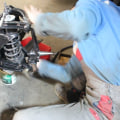The Triumph TR models are some of the most iconic cars from the classic era of motoring. From the TR2 to the TR7, these cars have been beloved by enthusiasts around the world for decades. But what about those other Triumph TR models that don't get as much attention? This article explores the history and legacy of these lesser-known TR models, from the TR3 to the TR8. Whether you're a long-time fan of these classic cars or just discovering them for the first time, this is your guide to restoring other Triumph TR models. The first step in restoring any Triumph TR model is to gather the necessary parts and tools. This includes items such as engine and transmission parts, body panels, interior trim, and suspension components.
Additionally, you will need restoration tools such as wrenches, screwdrivers, sanders, and paintbrushes. It is important to have a complete list of parts and tools before starting the restoration process. Next, the vehicle must be disassembled. This includes removing the body panels, interior trim, engine components, and transmission. Once the parts are removed, they should be cleaned thoroughly to remove any dirt or rust.
The parts should then be inspected for damage or wear and replaced if necessary. Once the parts have been cleaned and inspected, the vehicle can then be reassembled. This includes putting the engine and transmission back together, installing the body panels, interior trim, and suspension components. During this process, it is important to ensure that all parts are properly tightened and secured. The final step in restoring a Triumph TR model is painting.
This involves applying several coats of primer, base coat, and clear coat to the vehicle's exterior. Additionally, any interior trim or accessories should be painted to match the exterior. Throughout the restoration process, it is important to pay attention to detail and take your time. It is also important to keep records of all parts and tools used in the restoration process.
This will help you stay organized and ensure that all aspects of the restoration are completed correctly.
Tips for Keeping Your Restoration Project on Track
Restoring a Triumph TR model can be a lengthy process, so it is important to stay organized and focused on your goals. To ensure that your restoration project is successful, you should keep detailed records of all parts used in the restoration process and set realistic deadlines for each stage of the process. Additionally, enlisting the help of a knowledgeable friend or professional mechanic can be useful if you encounter any difficulties along the way. With the right preparation and dedication, you will be able to complete your Triumph TR restoration project on time and within budget.Finding Parts for Your Restoration Project
Finding original parts for your restoration project can be a challenge.Many online retailers specialize in selling Many online retailers specialize in selling vintage auto parts, but these can be expensive. You may also find parts at local swap meets or junkyards. However, it is important to inspect any used parts before purchasing them to ensure that they are in good condition. In addition, you may be able to find OEM parts for your specific Triumph TR model from a dealership, but these can be difficult to locate.
You should also consider checking with other car enthusiasts who may have the parts you need. If you can't find the parts you need through any of these sources, you may have to consider buying aftermarket parts. When searching for the right parts for your restoration project, it is important to consider quality. It may be tempting to buy the cheapest parts available, but this could lead to problems down the road. Be sure to research the parts you are considering before making a purchase. Restoring other Triumph TR models can be a rewarding experience for car enthusiasts.
With the right parts and tools, a bit of patience, and dedication, you can take a classic car in disrepair and bring it back to life. Documenting each step of the restoration process is key to keeping your project on track. With these tips in mind, you will be well on your way to creating a beautiful vintage automobile.


